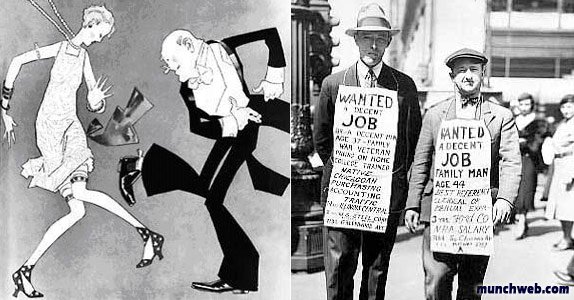The Twenties and Thirties: Human Nature in Times of Change
Dickens once, so simply, stated, “It was the best of times, it was the worst of times.” This perfectly encapsulates the era of the twenties and thirties. It was an era of multifarious metamorphosis, socially, economically, politically, and artistically. And what usually accompanies such beneficial growth is a great of deal pain. However, when withstanding the afflictions of advancement, mankind’s enduring hopefulness, dependence on others, and reliance on artistic expression is clearly reflected.
One of the greatest characteristics of human nature, especially during change, is the perseverance of faith. The lyrics within James Weldon Johnson’s song “Lift Every Voice and Sing” exemplify this faith. It addresses the hope accompanying every new day and the march we continue through life until we achieve “the victory.” In those lyrics specifically, there are religious references, demonstrating a major component to human faith: spirituality. However, there is also faith in regard to overcoming challenging stages of life and reaching years of betterment. Take the Dust Bowl for example, a particularly challenging era for the Midwestern farmer. When the fertile soil reduced to dry dust the farmers had nowhere else to turn but west towards California. The idealization of state is illustrated through numerous works including John Steinbeck’s novel, Grapes of Wrath. California became a symbol of hope and that hope allowed the migrant farmers to withstand the grueling trip towards the coast.
When the chaos of change falls upon people, humans tend to rely on the concept of community. The sharing of goods, news, and labor are necessities in an individual’s continuation. However, communities aren’t only essential of physical survival, but also mental well-being. Isolation is a detriment to the human psyche, which desires feeling of togetherness. In the essay “I Remember the Thirties” Steinbeck writes “But I do remember it as a time of warmth and mutual caring…Everyone shared bad fortune as well as good.” The human spirit can prove to be quite resilient, and when fed the ideas of hope and brotherhood it can bear the turbulence of time.
Art has always been one of the fundamental outlets and anodynes for suffering people. The twenties were no exception; in fact the world experienced the resurgence of another Renaissance. However, instead of being located in Italy, it sprung from the African-American community within Harlem, New York. The Harlem Renaissance and its protest for equality inspired new forms of music and some of the greatest literature of the twentieth century. It also inspired numerous painters including Archibald Motley and his piece, nightlife. The piece illustrates the excitement, energy, and celebration within Harlem. Another prolific artist, Langston Hughes, and famous poem, Theme for English B, exposes the darker sides of Harlem, including the continual combat against racial prejudices. Whether reflecting the struggle or the celebration, art becomes a primary source of documentation and revolutionary statements during such eras.
Periods of great change can bring on a rare excitement along with egregious hardships. What keeps us all pushing forward is the faith in a better future. What provides us with the means of survival is the community we rely on. And what allows the change to occur and the better future to finally arrive is the persistent protests and illustrations through artistic mediums.
